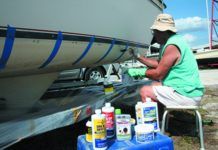Peltier Guts
Your recent Refrigeration Survey [October 1, 2002] has rekindledan old desire: I’ve often wondered if a thermoelectric plate, the type used in those small,portable, 12-volt cooler warmersthat first appearedback in the late ’70s, might be sufficiently improvedby now to work well inthe3.5 cu. ft.icebox Ibuiltinto our’77 Norstar Flicka. Insulation consists of 4″ of polyisocyanurate foam, from two layers of 2″ foil-backed foamboard on top (including lid), sides, and against the hull. All spaces werefilled with canned foam and the insideisgel-coated. No drains, but a 1/2″ PVC sounding tube to the bottom to receive a vinyl siphon tube.
We don’t needto make ice, only to extenda 50-pound block beyond its current two- week lifespan. We have 5 amps from the outboard and 1.4 from solarcells, supplying two deep-cycle marine gel-cell batteries.Our other power requirements are minimal. Have you heard of any such applications?
-Bill Ronstadt
Tucson, AZ
Origo, the Swedish company known for stoves, used to make a Peltier-effect icebox conversion kit called the marinCool (covered in PS, January 15, 1999), but no longer does. According to the people at Waeco/Adler-Barbour, several companies do make Peltier-type cooling units that you can fasten to the inside of your ice chest, and one of these might have the same effect. It can’t take the temperature lower than about 40 below ambient, but it would certainly help extend the life of your ice block. Try visiting www.peltier-info.com for more information. It’s been a few years since we took a good look at thermoelectric coolers, so we’re gearing up again.
———-
Proper Outboard Propping
We thought we’d run this valuable letter to follow up our recent discussions of outboard engine power in this column. The issue of prop size and pitch often plays second fiddle to other concerns, but it’s central, and we thank Mr. Below for covering it for us.
This is in response to Mr. Patrick Green’s question about outboard power for a Pearson 26 [PS Advisor, February 15].
I owned a 1975 P-26 for nearly 20 years (traded up to a 10-M in ’99), cruising Long Island Sound and out to Nantucket. I acquired a ’76 9.9-hp Johnson, 20″ shaft with electric start, which I used for most of those years. I still own this engine.
The standard propeller for the Johnson was a 9-1/2″ diameter by 10″ pitch. This propeller did not allow the engine to reach its intended operating rpm, and as a result the engine fouled spark plugs and would not keep the battery charged. I quickly changed to the optional 10″ x 5″ “barge” propeller offered by OMC. This low-pitch propeller made all the difference. Plug fouling stopped, and the higher operating rpm allowed the alternator to keep the battery fully charged.
In 1995, I succumbed to the desire to own a more environmentally friendly four-stroke engine and purchased an 8-hp Honda, manual start, 20″ shaft. The stock Honda prop was 9″x 10″, I believe, and did not allow the engine to reach its recommended operating rpm.
I switched to a 8-3/4″ x 7″ Michigan prop. This was a perfect match for the P-26. The engine ran great, and the 4-amp alternator was able to keep the battery charged. The Honda burned about half the fuel (and no oil), compared to the old Johnson.
My experience says that many people overlook the necessity for matching the propeller to their boat. It is absolutely crucial to allow engines, especially older two-stroke outboards, to be able to reach their recommended maximum power at full throttle. This also holds true for modern, high-rpm inboard diesels.
-Dexter Below
Wilton, CT





































